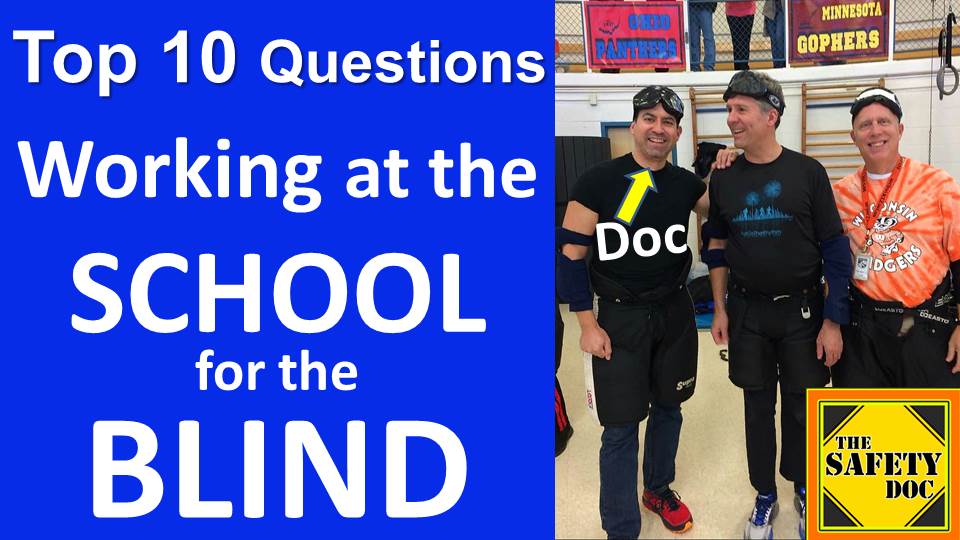Top Ten Questions About Working At The School For The Blind | Do Some Students Drive? SDP162
[Podcast] Have you wondered what life is like for staff and students at a state residential school for blind children? In this episode, Doc shares his experiences as the director of rehabilitation services for a school for the blind. Did his expectations match what he encountered with the job? What are things few people know about working with visually impaired students? Why was there a swingset inside of the school? How did working with visually impaired students and staff change the ways that Doc thought about school safety? His book, School of Errors – Rethinking School Safety in America, was written during the time he worked at the school for the blind. Here are the top ten questions about working at the school for the blind.

DIRECT LINK to MP3 of this Episode: https://tinyurl.com/SDP162-AUDIO
(1) DO STAFF HAVE TO LEARN BRAILLE? Surprisingly, no. Most staff learn how to visually read the Braille alphabet and common words, but learning to read and write tactile Braille is required primarily of instructors of Braille. A student taught Doc the Braille alphabet and he used a free “Braille Helper” phone app to practice words written in the six dots braille system (Braille is not a language, but a way to communicate a language).
(2) IS IT A SAD PLACE TO WORK? No. With less than a hundred students and a high staff-to-student ratio, the campus had a positive tone. There was little staff turnover and students had an array of activities to participate in during school and after hours.
(3) ARE THERE SPORTS AND EXTRACURRICULARS? Yes. The school offered track, swimming, wrestling, 4H, and numerous clubs. The most popular sport was goalball. At one time, the school had its own radio station and former students continue to work in radio and communications.
(4) DO THE STUDENTS LIVE AT THE SCHOOL? Most of the students stay in the dorms during the week – especially students who live 90 minutes away from the school. In fact, some students are flown into the local airport each Sunday for school and then flown back home on Fridays. Other students are transported to the campus daily and some split time between the campus and local schools or the two-year college.
(5) DO THE OLDER STUDENTS DATE? Yes. This is similar to students in other school settings. However, online matchmaking presents unique challenges for blind students as dating apps aren’t accessible and students sometimes ask staff to help them complete dating profiles and give opinions on their potential matches. Staff divert those questions to the students’ adult friends or sighted peers.
(6) ARE ALL OF THE STUDENTS BLIND? All of the students have some level of vision loss that meets criteria for them to receive services at the school for the blind. However, some students have partial sight and a few are even able to obtain a driver’s permit for daytime driving!
(7) DO STUDENTS GET INTO TROUBLE? Yes, but staff with experience at different school settings generally concur that school discipline incidents happen less frequently and with less severity at the school for the blind. Typical violations of the code of student conduct might be bullying or having tobacco on campus.
(8) HOW IS SCHOOL SAFETY ADAPTED FOR BLIND STUDENTS? There is a heavy emphasis on verbal communication and teaching students to identify landmarks, such as the perimeter sidewalk that loops the campus. Safety-purposed phone apps are seldom reliable for students with vision loss as such apps don’t have VoiceOver features to read information or present choice menus. All students participate in all safety instruction and all drills.
(9) WHO WOULDN’T WANT TO WORK THERE? A hurdle for new employees is that students’ schedules are very fluid. This is due to orientation and mobility instruction and braille courses taking priority along with maximizing field practice. If a residential student is ill, they typically miss the entire week of school due to transportation schedules of picking students up on Sundays and taking them home on Fridays. As all students at the school have disabilities, working there can present a moral dilemma for people who believe that it isn’t an inclusive setting and that students should be educated in their schools of residence.
(10) WHAT ARE THE MOST UNIQUE EXPERIENCES FOR STAFF? It was common for half the school’s staff and students to go on impromptu bike outings on warm fall or spring days. The school had tandem or three-wheeled bikes and a staff member or community volunteer was paired with a student. Doc describes a special CPR awareness project he helped a student work on which brought in the local TV and the student was given awards at an assembly. And, there was the pesky dorm cow that roamed the hallways at the most inopportune times!
This is episode 162 of The Safety Doc Podcast published on 12-13-2021.
FOLLOW
- Watch this episode on “The Safety Doc” YouTube channel https://tinyurl.com/SDP162-VIDEO
- Listen to this episode on PodBean MP3 https://tinyurl.com/SDP162-AUDIO
- Apple Podcasts http://tinyurl.com/SafetyDocApplePodcasts
- SAFETY DOC WEBSITE & BLOG safetyphd.com
- Follow David & The Safety Doc Podcast on Twitter @SafetyPhD
- Email Dr. Perrodin [email protected]
Purchase Dr. Perrodin’s books
School of Errors – Rethinking School Safety in America
The Velocity of Information – Human Thinking During Chaotic Times
